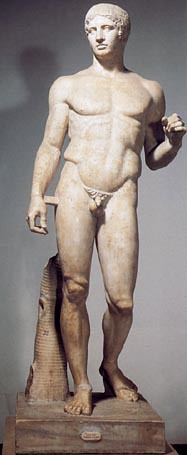
The principal legacy to the modern architect and decorator from the artists of Classic antiquity has been in the so-called "Orders of Architecture." This name has led to some confusion in the mind of the layman. It is in reality a term meaning a column and entablature. The column is a support and the entablature is a structure which is supported.
The orders were originated by the races of the Greek peninsula and their names have been given to designate the various types. The Dorians, Ionians, and Corinthians have given us the Doric, Ionic and Corinthian orders. The Greeks developed the proportions, ornamental pediment, and moldings of these architectural forms to the same high degree of perfection to which all other Grecian art forms were developed.
The Doric order was the heaviest in its aspect and is today used where it is necessary to express strength and vigor. The Ionic order was more graceful and was used where greater richness or splendor was desired. The Corinthian order of Greece was florid and was developed after the Ionic for greater richness than the latter could indicate.
The orders as we use them in the majority of instances today are those that were developed by the Romans, who inherited the idea from the Greeks, and adapted it to their own use. With a more systematic mind than the Greeks and with mass and quantity of production to be considered in their fast expanding Empire, they debased the detail of the orders, hut systematized them to a formula so that lesser artists could reproduce them.
They also introduced two additional orders. The Roman orders are known today as Tuscan, Doric, Ionic, Corinthian and Composite. Standard proportions were established by the architect, Vitruvius, and were later re-established in the sixteenth century in Italy by Yignola. These proportions were based on the diameter of the column near its base compared with its height and are as follows:
Tuscan column-7 diameters high
Doric column-8 diameters high
Ionic column-9 diameters high
Corinthian column-10 diameters high
Composite column-10 diameters high
The entablature in each ease was one-quarter the height of the column. Each column was divided into three parts, the base, shaft, and capital. Each entablature was also divided into three parts, the architrave, frieze, and cornice. While there were differences in detail in the moldings of all the orders for the corner guards and plinth blocks, the most obvious difference is noted in the capital of the columns. There is also a great difference in the shape of Greek and Roman moldings. All Greek curved moldings are irregular curves, designed by a free-hand stroke of the pen and especially studied for grace of form, silhouette, shade and shadow.
Roman curved moldings are all parts of a circle that could be drawn by a compass by an untrained artisan. The principal Roman moldings are as follows:
Fascia (a long straight line)
Fillet (a short straight line)
Torus (a semi circle)
Ovolo (a quarter circle)
Cyma (an ogee, or S-shaped molding)
Scotia (two quarter circles of different diameters joined together)
Both Roman and Greek moldings were enriched by a similar type of conventional ornament. The honeysuckle form of Greek decoration and the acanthus leaf of Roman formed a basis for a whole series of varied motifs. The water-leaf, egg-and-dart, and head motif were constantly used to enrich all the orders. The anthemion is common in Greek forms, while rineeaux, grotesques, dolphins, griffins, wreaths, ribbons, eagles, and masks cover Roman friezes.
Color was used extensively to enrich both the exterior and interior of buildings. Brilliant examples of wall paintings have been found in Hereulaneum and Pompeii. These were rediscovered during the eighteenth century and had an immense influence upon the decoration and art of both France and England of that period. Strong primary colors were used in a semi-naturalistic, semi-fantastic representation of figures, architecture and landscape intermingled with vines, festoons and panels. The darker tones were used near the floor on structures such as wood stoves and wood fireplace inserts, while the chimneys and door toppers closer to the ceiling had lighter tones.
Classical furniture was made in wood, metal and stone. The majority of wooden pieces have disappeared, but wall paintings show that they had turned legs and painted decorations. From ancient manuscripts we find that the furnishing of the palaces of the emperors was extravagantly rich. The rarest of materials were used. Gold, silver and precious stones adorned the chairs, couches and tables. The metal furniture sometimes had metal supports turned in imitation of wooden ones. The best, however, had supports patterned after animal legs and feet. Table tops were usually in marble.
Allison Ryan is a freelance marketing writer from San Diego, CA. She specializes in the history of architecture and interior design. For the best in the hardwood moulding industry, from ornamental pediment to wood fireplace inserts, stop by http://www.ferche.com/.